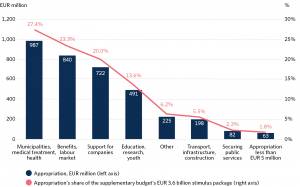The fourth supplementary budget approved by Parliament is what is called a stimulus package. The earlier supplementary budgets approved this spring due to the coronavirus pandemic focused on supporting companies and households during the restriction measures. The fourth supplementary budget, on the other hand, aims to stimulate the Finnish economy, i.e. to increase domestic demand – in both consumption and investments – once the restrictions are eased or lifted.
The transparency of the fourth supplementary budget is weakened by the fact that, in addition to actual stimulus measures, it contains other appropriations mainly related to public administration. Typically, these needs for additional appropriations that emerge subsequent to the approval of the actual budget proposal are addressed in the year’s first supplementary budget. Due to the exceptional nature of the past spring, however, they are now included in only the fourth supplementary budget. These increases in the operating expenses of public administration and some proposals for appropriations amount to approximately EUR 400 million, under a total of 106 different items. The largest individual appropriation is a EUR 110 million increase in the purchasing of vaccines. In the interest of transparency and clarity, it might have been in order to give a separate proposal for a supplementary budget.
The appropriations proposed for 2020 included in the actual stimulus package amount to EUR 3.6 billion, under a total of 68 items. Of this sum, EUR 0.56 billion are two-year and EUR 1 billion three-year appropriations carried forward, given that these items are classified as deferrable appropriation items in the budget. Despite the classification, the budgeting for these items typically covers only the needs of the current year.
What is the breakdown of the stimulus package?
The figure below depicts the appropriations included in the stimulus package, broken down across different areas of society. Items with an appropriation of less than EUR 5 million have not been classified. (Such appropriations, amounting to less than EUR 5 million, total EUR 63 million under 29 different items.)
A billion (27%) of the appropriations for 2020 is allocated to municipalities and hospital districts. The appropriations support and secure municipalities’ basic services and local government finances, which were experiencing difficulties even before the pandemic. Approximately EUR 840 million (23%) is allocated to labour market benefits and the unemployment benefits of people who have been laid off, and the sum thereby supports domestic demand.
Some EUR 720 million (20%) is allocated to support for businesses. This sum includes business cost support (EUR 300 million), as well as capital investments in the Finnish Minerals Group (Suomen Malmijalostus Oy) (EUR 150 million) and Finnish Industry Investment (Tesi) (EUR 250 million). Nearly EUR 500 million (14%), on the other hand, has been reserved for education, research and youth.
Overall, these appropriations increase public spending and thus expand the economy immediately. On the other hand, they create a basis for long-term economic growth – even if the magnitude of this effect is difficult to estimate.

Other areas of the stimulus package include transport and infrastructure as well as the securing of public services, such as support for the services of Employment and Economic Development Offices (TE Offices). The figure’s “Other” category includes expenditure arising from the purchase of and compensation for protected areas (EUR 18 million), promoting water and environmental management (EUR 28 million), the public administrative tasks of Metsähallitus (The Finnish Forest Administration) (EUR 10 million), and a transfer to the Development Fund for Agriculture and Forestry.
Stimulus targets compete over resources
For the most part, the appropriations seem well allocated from the perspective of stimulating the economy, although it is unclear whether this particular allocation of the appropriations is the most efficient way of doing so. When assessing the use of the appropriations, it must be noted that an increase in one item takes something away from another item. This means that the stimulus items compete for resources which must be divided so that the stimulus is most efficient precisely when accounting for the economic impact of the coronavirus. From this perspective, at least the allocations to the expenditure increases in the “Others” category may be questioned. For example, by removing the increase in the public administrative tasks of Metsähallitus (The Finnish Forest Administration), companies could have been supported by another EUR 10 million.
In the fourth proposal for a supplementary budget, the government has furthermore decided on authorisations of approximately EUR 1 billion[1] to primarily transport infrastructure development and higher education, as well as research, development, and innovation operations, and a capital investment in the Finnish Minerals Group. These appropriation effects will take place in 2021–2024. It is also proposed that the authorisation of the National Housing Fund be increased by EUR 0.35 billion, and that the corporation tax distribution quota between central and local government be changed by EUR 0.5 billion for the benefit of local governments.
Change in corporation tax distribution quota important to support local government finances
According to the supplementary budget, the size of the stimulus package is roughly EUR 5.5 billion, of which the appropriations for 2020 amount to EUR 3.6 billion. Approximately EUR 1 billion of the authorisations’ appropriation effects concern 2021–2024, the authorisation increase of the National Housing Fund is EUR 0.35 billion, and the change in the corporation tax distribution quota for the benefit of local governments in 2020–2021 is EUR 0.5 billion in total, of which approximately EUR 0.41 billion concerns the year 2020. The change in the corporation tax distribution quota is nevertheless a current transfer within the public sector and cannot therefore be counted directly as a stimulus – i.e. an increase in public demand. Yet it is an important and significant part of supporting local government finances and securing municipal jobs and services in a situation in which the revenues of many municipalities will contract as local income and municipal corporation tax decline due to the coronavirus restrictions (Opens in a new tab).
Take a look at our visualisation of the entire range of economic measures carried out during the coronavirus crisis: Economic impacts of the coronavirus pandemic. (Opens in a new tab)
[1] Actual decisions are worth some EUR 0.8 billion. The rest, EUR 0.2 billion, are based on the minutes of the government’s budget session, which still require a decision in the following budget proposals.







